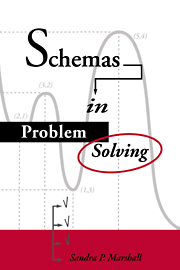Crossref Citations
This Book has been
cited by the following publications. This list is generated based on data provided by Crossref.
Appleton, Ken
1995.
Problem solving in science lessons: How students explore the problem space.
Research in Science Education,
Vol. 25,
Issue. 4,
p.
383.
Derry, Sharon
1996.
Cognitive schema theory in the constructivist debate.
Educational Psychologist,
Vol. 31,
Issue. 3,
p.
163.
Singley, Mark Kevin
and
Bennett, Randy Elliot
1997.
VALIDATION AND EXTENSION OF THE MATHEMATICAL EXPRESSION RESPONSE TYPE: APPLICATIONS OF SCHEMA THEORY TO AUTOMATIC SCORING AND ITEM GENERATION IN MATHEMATICS.
ETS Research Report Series,
Vol. 1997,
Issue. 2,
Sheehan, Kathleen M.
1997.
A TREE‐BASED APPROACH TO PROFICIENCY SCALING.
ETS Research Report Series,
Vol. 1997,
Issue. 1,
Sheehan, Kathleen M.
1997.
A TREE‐BASED APPROACH TO PROFICIENCY SCALING & DIAGNOSTIC ASSESSMENT.
ETS Research Report Series,
Vol. 1997,
Issue. 1,
Sheehan, Kathleen M.
1997.
A Tree‐Based Approach to Proficiency Scaling and Diagnostic Assessment.
Journal of Educational Measurement,
Vol. 34,
Issue. 4,
p.
333.
MacGregor, Mollie
and
Stacey, Kaye
1998.
Cognitive models underlying algebraic and non-algebraic solutions to unequal partition problems.
Mathematics Education Research Journal,
Vol. 10,
Issue. 2,
p.
46.
Jitendra, Asha K.
Griffin, Cynthia C.
McGoey, Kara
Gardill, M. Cathleen
Bhat, Preetha
and
Riley, Tamar
1998.
Effects of Mathematical Word Problem Solving by Students At Risk or With Mild Disabilities.
The Journal of Educational Research,
Vol. 91,
Issue. 6,
p.
345.
Surkan, Alvin J.
1998.
APL-generated teaching and testing items to enhance a student's ability to discover functional relationships.
p.
98.
Bennett, Randy Elliot
Morley, Mary
and
Quardt, Dennis
1998.
THREE RESPONSE TYPES FOR BROADENING THE CONCEPTION OF MATHEMATICAL PROBLEM SOLVING IN COMPUTERIZED‐ADAPTIVE TESTS.
ETS Research Report Series,
Vol. 1998,
Issue. 2,
Chinnappan, Mohan
Lawson, Michael J.
and
Gardner, Dane
1998.
The use of microcomputers in the analysis of mathematical knowledge schemas.
International Journal of Mathematical Education in Science and Technology,
Vol. 29,
Issue. 6,
p.
805.
Reeves, Darian
Burns, John
Paris, Carol
Johnston, Joan
and
Lyons, Denise
1998.
Application of Hand-Held PC Technology to Support Evaluation of Tactical Decision Making Performance.
Proceedings of the Human Factors and Ergonomics Society Annual Meeting,
Vol. 42,
Issue. 20,
p.
1422.
Surkan, Alvin J.
1998.
APL-generated teaching and testing items to enhance a student's ability to discover functional relationships.
ACM SIGAPL APL Quote Quad,
Vol. 29,
Issue. 2,
p.
98.
Chinnappan, Mohan
1998.
The accessing of geometry schemas by high school students.
Mathematics Education Research Journal,
Vol. 10,
Issue. 2,
p.
27.
Mathewson, James H.
1999.
Visual-spatial thinking: An aspect of science overlooked by educators.
Science Education,
Vol. 83,
Issue. 1,
p.
33.
Bennett, Randy Elliot
1999.
USING NEW TECHNOLOGY TO IMPROVE ASSESSMENT.
ETS Research Report Series,
Vol. 1999,
Issue. 1,
Bennett, Randy Elliot
1999.
Using New Technology to Improve Assessment.
Educational Measurement: Issues and Practice,
Vol. 18,
Issue. 3,
p.
5.
Jitendra, Asha K.
Hoff, Kathryn
and
Beck, Michelle M.
1999.
Teaching Middle School Students with Learning Disabilities to Solve Word Problems Using a Schema-Based Approach.
Remedial and Special Education,
Vol. 20,
Issue. 1,
p.
50.
Singley, Mark K.
Singh, Moninder
Fairweather, Peter
Farrell, Robert
and
Swerling, Steven
2000.
Algebra jam.
p.
145.
Paris, Carol
Johnston, Joan Hall
and
Reeves, Darian
2000.
The Human in Command.
p.
263.



